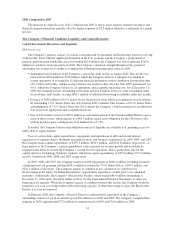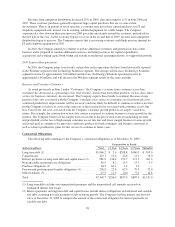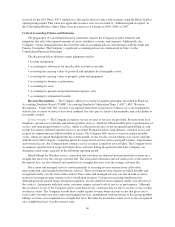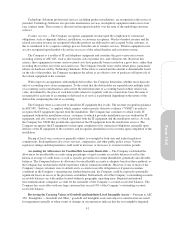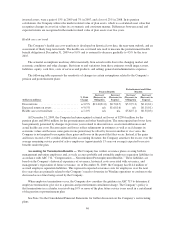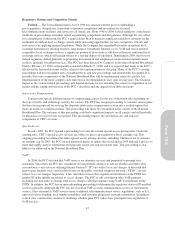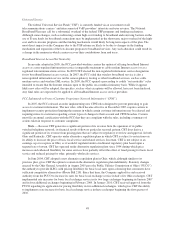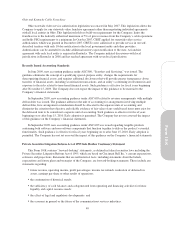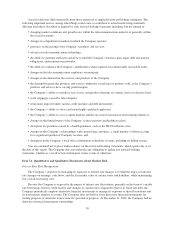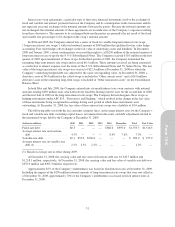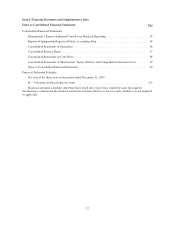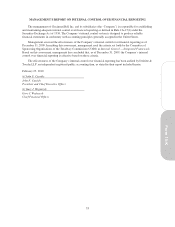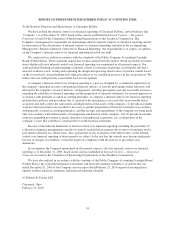Cincinnati Bell 2009 Annual Report Download - page 114
Download and view the complete annual report
Please find page 114 of the 2009 Cincinnati Bell annual report below. You can navigate through the pages in the report by either clicking on the pages listed below, or by using the keyword search tool below to find specific information within the annual report.Operating Taxes
The Company incurs certain operating taxes that are reported as expenses in operating income, such as
property, sales, use, and gross receipts taxes. These taxes are not included in income tax expense because the
amounts to be paid are not dependent on the level of income generated by the Company. The Company also
records expense against operating income for the establishment of liabilities related to certain operating tax audit
exposures. These liabilities are established based on the Company’s assessment of the probability of payment.
Upon resolution of an audit, any remaining liability not paid is released and increases operating income. The
Company recognized income of $0.5 million in 2009, expense of $1.5 million in 2008 and income of $2.4
million in 2007 upon resolution of operating tax audits, net of new liabilities established.
The Company incurs federal regulatory taxes on certain revenue producing transactions. The Company is
permitted to recover certain of these taxes by billing the customer; however, collections cannot exceed the
amount due to the federal regulatory agency. These federal regulatory taxes are presented in sales and cost of
services on a gross basis because, while the Company is required to pay the tax, it is not required to collect the
tax from customers and, in fact, does not collect the tax from customers in certain instances. The amount
recorded as revenue for 2009, 2008, and 2007 was $16.7 million, $16.6 million, and $17.3 million, respectively.
Excluding an operating tax settlement gain of $10.2 million in 2008, the amount expensed for 2009, 2008, and
2007 was $17.2 million, $17.0 million, and $18.2 million, respectively. The Company records all other taxes
collected from customers on a net basis. In the fourth quarter of 2008, the Company settled certain operating tax
issues and as a result recorded $10.2 million of income, which is presented as an “Operating tax settlement” in
the Consolidated Statements of Operations.
Accounting for Pension and Postretirement Expenses — In accounting for pension and postretirement
expenses, the Company applies the accounting requirements of ASC 715 “Compensation — Retirement
Benefits.” ASC 715 requires the Company to recognize the funded status of its defined benefit pension and
postretirement benefit plans on the consolidated balance sheet and recognize as a component of accumulated
other comprehensive income (loss), net of tax, the gains or losses and prior service costs that arise during the
period, but are not recognized as components of net periodic benefit cost.
The Company sponsors three noncontributory defined benefit pension plans: one for eligible management
employees, one for non-management employees, and one supplemental, nonqualified, unfunded plan for certain
senior executives. The Company also provides health care and group life insurance benefits for eligible retirees.
The Company’s measurement date for its pension and postretirement obligations is as of December 31st of each
year. When changes to the plans occur during interim periods, the Company reviews the changes and determines
if a remeasurement is necessary.
In 2009, the Company announced significant changes to its management pension plan and its postretirement
plans. The Company announced that it will freeze pension benefits for certain management employees below 50
years of age and provide a 10-year transition period for those employees over the age of 50 after which the
pension benefits will be frozen. Additionally, the Company announced it will phase out the retiree healthcare
plans for all management employees and certain retirees in 10 years.
The significant changes in 2009 caused a 90% decrease in the expected future service years for active
participants in the management pension plan, which triggered a plan curtailment. The curtailment gain of $7.6
million consisted of the acceleration of unrecognized prior service benefits. The Company also determined that
the significant changes to the postretirement plan benefits required a remeasurement of these plans. The
Company remeasured its management pension plan and its postretirement plans, using revised assumptions,
including modified retiree benefit payment assumptions, revised discount rates and updated plan asset
information. Additionally, the Company determined that these benefit changes result in substantially all of the
remaining participants in the management postretirement plan to be either fully eligible for benefits or retired. As
such, the unrecognized prior service gain and unrecognized actuarial gains are amortized over the average life
expectancy of the participants rather than the shorter service periods previously used. As a result of the
remeasurement, the Company’s pension and postretirement obligations were reduced by approximately $124
million, deferred tax assets were reduced for the related tax effect by $45 million, and equity was increased by
$79 million.
44


